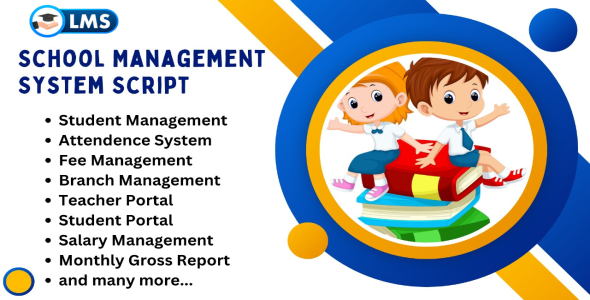
Latest Online School
This School Script allow you to manage for all types of educational institutions like schools and colleges etc. Go To Buy Page
View Demo
lms script
The term "LMS script" refers to a Learning Management System script, which is a pre-developed software solution written in PHP or other programming languages to facilitate the management of online learning platforms.
These scripts offer a wide range of features to streamline various aspects of educational administration, such as course creation, student management, assessments, communication, and more.
LMS scripts are designed to provide a user-friendly interface for instructors, students, and administrators, allowing them to interact, access course materials, track progress, and engage in online learning activities effectively.
Popular LMS scripts include Academy Learning Management Systems, Codename, Moodle, Caroline, and ILIAS, each offering unique features and capabilities to support the creation and management of online courses.
Additionally, LMS scripts play a crucial role in enhancing the online learning experience, promoting engagement, collaboration, and effective learning outcomes within educational institutions and corporate training environments.
how to install an lms script:To install an LMS script, you can follow these general steps:
Download the script from a trusted source, such as a reputable website or a Codeslook repository.
Extract the script files from the archive file (if applicable) and copy them to a directory on your server.
Configure the script by editing the configuration files (usually named "lms.ini" or "lms-mgc.ini") and setting the appropriate values for your environment.
Move the script files to the appropriate directories on your server, such as /usr/sbin for executable files and /etc/lms for configuration files.
Set the appropriate permissions on the script files and directories to ensure that the script can be executed and that the configuration files are protected.
Test the script to ensure that it is working correctly and that you can access the LMS interface.
It is important to note that the specific steps for installing an LMS script may vary depending on the script and your server environment. It is recommended to consult the documentation provided with the script or to seek assistance from the script's developers if you encounter any issues during the installation process.
what are the system requirements for installing an lms script:
The system requirements for installing an LMS script typically include the following:
Processor: A processor of 500MHz or faster.
RAM: At least 128MB of RAM.
Video Card: A video card with a minimum of 128MB of video memory.
Sound Card: A sound card with a minimum requirement of 16-bit.
Additionally, for specific LMS scripts like Winshuttle License Management System, the system requirements may include:
CPU: Quad-core
Memory: 8GB
Storage: 5-10GB for the system drive
Permissions: The account used to install the LMS should have Administrator permissions on the target system, db creator on the SQL server where the LMS database will be created, and security admin on the SQL server where the LMS database will be created.
what are the key features of an lms script:
The key features of an LMS script include:
Course Management:
Ability to easily deliver course content to learners, allowing for drag-and-drop content arrangement and support for multiple formats like PDFs, videos, and live training sessions.
SCORM & xAPI Compliance:
Capability to upload SCORM and xAPI course files seamlessly, ensuring compatibility with standard learning content formats.
Learning Portals:
Functionality to create Learning Portals for different audiences within the organization, enabling separate learning goals and needs for various departments.
User Experience:
Providing a great user experience for both learners and administrators, ensuring ease of use and effective training delivery.
Course Creation:
Simplifying the process of creating courses by offering intuitive tools for content creation and organization.
Monitoring & Reporting:
Tracking learner progress, performance, and engagement, offering insights through detailed reports and analytics.
Flexibility:
Allowing learners to access training content anytime, anywhere, often at their own pace, promoting a flexible learning environment.
Collaborative Tools:
Incorporating features like forums, chats, and group projects to encourage interaction and social learning among learners.
Customization:
Providing options for customization, such as white-labeling, to tailor the LMS platform to specific branding needs.
Integration:
Supporting integration with other systems like HRIS for seamless training and development purposes.
what are the most important features to look for in an lms script:
